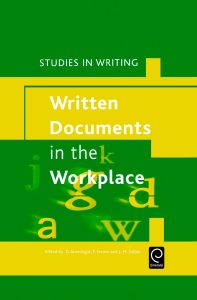
Edited by: Jean-Marie Cellier, Patrice Terrier and Denis Alamargot
Divided into three parts, the first of which provides a linguistic definition of professional documents, describing their different types and genres. This definition necessarily takes into account both the formal characteristics of these types of document (e.g. nature of linguistic units involved) and their functional goals (the way these linguistic units are used to fulfill the text’s communicative aim). The second part focuses on the mental mechanisms involved in written production in the workplace. One of the aims of a professional writer is to compose a text which can be understood. Text composition involves specific processes and strategies that can be enhanced. One way of doing this is to give the writer suitable instructions, while another is to provide him/her with a suitable writing environment. This last aspect leads us to devote the third and final section to the comprehension of written documents in the workplace. Awareness of the strategies implemented by different readers (with more or less domain expertise) in order to understand technical and professional documents can enhance the latter’s readability.
*Contributions from linguists, psychologists and ergonomists from various countries ensure international scope and comprehensiveness
*Bridges the gap between fundamental research into writing and reading and the issue of the efficiency of written communication in the workplace
*Enables better content creation for professional writers
Download
http://usafiles.net/D7o/Written_Documents_in_the_Workplace.pdf